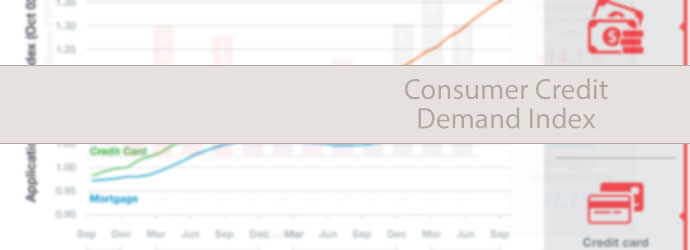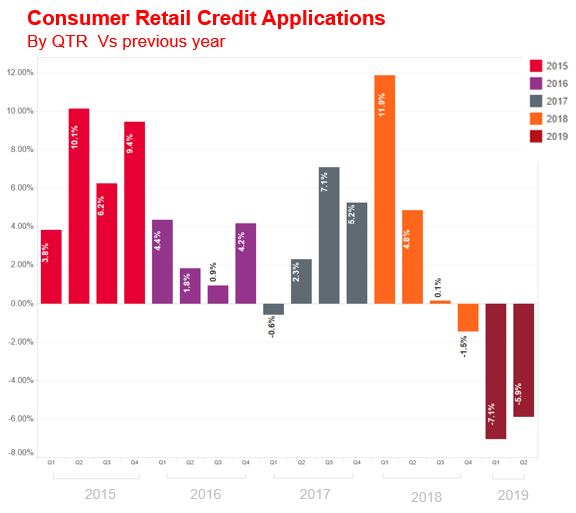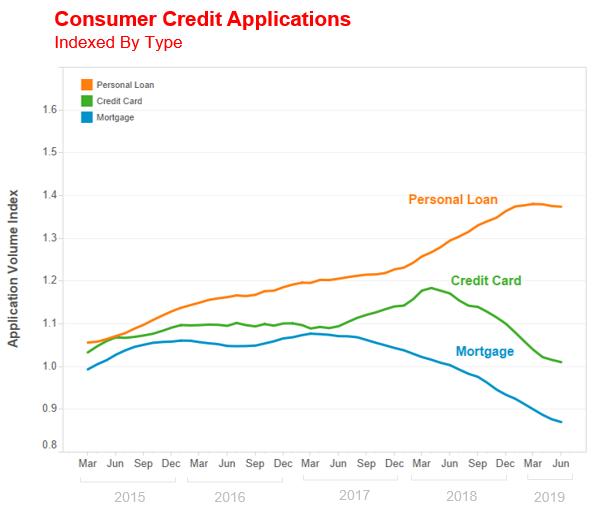Consumer credit demand rate of decline eases
Consumer Credit Demand Index by Equifax (June 2019 Quarter)
Overall consumer credit applications down -5.9% (vs June quarter 2018), credit card applications declined by -10.4% (vs June quarter 2018) and personal loan applications also softened, by -2.0% (vs June quarter 2018).
Mortgage applications declined by -11.9% (vs June quarter 2018).

Sydney, Australia – Monday, 12 August 2019: Consumer credit demand remains soft, down -5.9% in the June 2019 quarter (versus the same period last year), according to data from the latest Quarterly Consumer Credit Demand Index by Equifax.
Released today by Equifax, the global data, analytics and technology company and the leading provider of credit information and analysis in Australia and New Zealand, the Index measures the volume of credit card and personal loan applications.
The Quarterly Consumer Credit Demand Index shows that the rate of decline in consumer credit applications appears to be easing compared to the March 2019 quarter (-7.1%).
Credit card applications declined (-10.4%) in the June quarter vs the same time last year.
After multiple quarters of growth, demand for personal loans softened to -2.0% in the June 2019 quarter. All states and territories declined except for WA.
The Quarterly Consumer Credit Demand Index by Equifax provides an early indication of movements in consumer spending and retail sales.
Moses Samaha, Executive General Manager Customer and Solutions, Equifax said “While overall consumer credit demand has continued to decline, it does appear we may be starting to see some green shoots in the economy and a softening of the decline”, Mr Samaha said.
The decline in credit card applications has been driven by a rise in Buy Now Pay Later services, as well as changes to ASIC regulations and government restrictions on credit card marketing.
“For credit cards, the reduction in applications is not as marked as the previous quarter, possibly due to the release of new marketing campaigns by several banks,” Samaha added.”
Credit card applications dropped in the June quarter. By geography, the largest decline was in ACT (-14.2%), followed by QLD (-12.1%), SA (-11.7%), NSW (-10.7%), VIC (-9.0%), WA (-9.0%), NT (-7.1%) and TAS (-7.0%).
Personal loans decreased across all states and territories except WA (+0.7) in the June quarter. The largest decline was seen in TAS (-4.9%), followed by NSW and ACT, both at -2.7%. Next was NT (-3.2%), QLD (-2.3%), SA (-2.2%) and VIC (-1.7%).
Mortgage demand declined -11.9% for the June quarter, the ninth consecutive quarter of decline in mortgage applications.
“While mortgage demand declined across all major states the rate of decline appears to be easing. In NSW, for example, the first quarter of this year showed a -16.6 per cent drop, but that has eased to -12.6 per cent in this second quarter.
“If we look at the volume of mortgage enquiries today compared to 2017, there is still a way to go. Second-quarter 2019 enquiry volumes are 82 per cent of what they were for the same quarter two years ago,” Mr Samaha said.
Historically, movements in Equifax mortgage application demand data has led movements in house prices by around six to nine months. Mortgage applications are not part of the Consumer Credit Demand Index but are a good indicator of home buyer demand and housing turnover.



About Equifax
Equifax is a global data analytics company using unique data, innovative analytics, technology and industry expertise to power organisations and individuals around the world by transforming knowledge into insights that help make more informed business and personal decisions.
Headquartered in Atlanta, Ga., Equifax operates or has investments in 24 countries in North America, Central and South America, Europe and the Asia Pacific region, with the acquisition of Veda, a data analytics company and the leading provider of credit information and analysis in Australia and New Zealand. Combined, the companies bring over 170 years of data and insights experience to the marketplace.
Equifax is a member of Standard & Poor's (S&P) 500® Index, and its common stock is traded on the New York Stock Exchange (NYSE) under the symbol EFX. For more information, visit www.equifax.com.au or follow the company’s news on LinkedIn.
Note to Editors
The Quarterly Consumer Credit Demand Index by Equifax measures the volume of credit card and personal loan applications that go through the Equifax Consumer Credit Bureau by financial services credit providers in Australia. Credit applications represent an intention by consumers to acquire credit and in turn spend; therefore, the index is a lead indicator. This differs to other market measures published by the RBA which measure credit provided by financial institutions (i.e. balances outstanding).
DISCLAIMER
Purpose of Equifax media releases:
The information in this release does not constitute legal, accounting or other professional financial advice. The information may change, and Equifax does not guarantee its currency or accuracy. To the extent permitted by law, Equifax specifically excludes all liability or responsibility for any loss or damage arising out of reliance on information in this release and the data in this report, including any consequential or indirect loss, loss of profit, loss of revenue or loss of business opportunity.
Related Posts

The latest data from Equifax reveals Australians demonstrated strong financial resilience in 2025, amid an ongoing cost-of-living crisis, the national average credit score remained in the ‘Excellent’ range at 864 (out of a possible 1200), lifting by three points from the 2024 average of 861.

Survey reveals broker anticipation of commercial loans has more than tripled over the past year, while 72% of brokers say they plan to work with customers dealing with ‘mortgage regret’ amid recent rate cuts.
